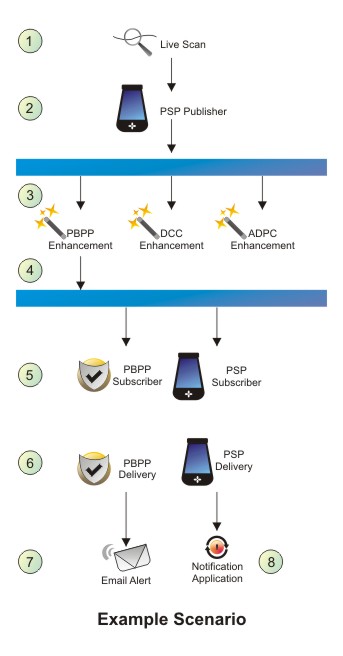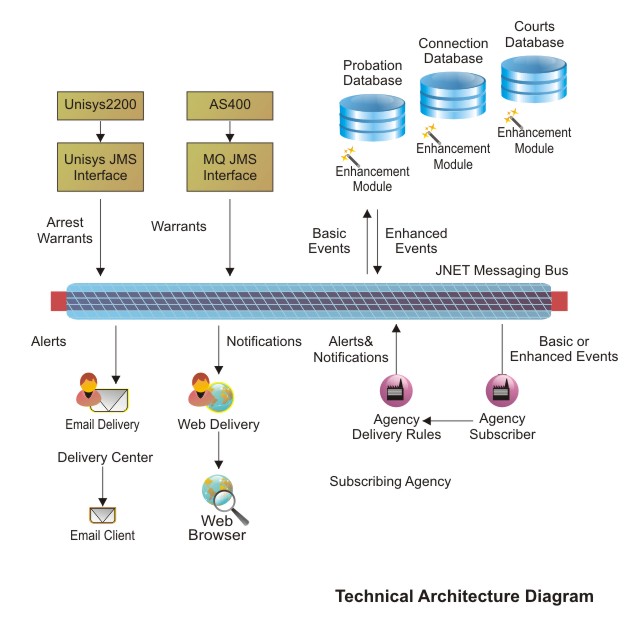|
FioranoMQ® : 司法ネットワークのメッセージング バックボーン
|
|
政府官公庁、地方自治体 : ペンシルバニア州政府 Justice NETwork
|
キーポイント
- アプリケーション インテグレーション (EAI)
- 疎結合
- エラー発生率の低減 (重複したデータ入力と人手によるデータ連結の削減も含む)
- インクリメンタル(段階的) なシステム拡張
- ビジネス プロセスとワークフローの自動化
- ピア ツー ピア アーキテクチャによる分散環境への対応
- スケーラビリティ
- インターネットを経由した公共サービス料金や税金のオンライン支払い
- 市民へのオンラインによる情報公開
|
『 我々は、Fiorano を採用しました。なぜなら、PKI 機能が製品に組み込まれていたからです。PKI 機能を必要としていたのですが、PKI を実装した製品は Fiorano 以外にはほとんどありませんでした。現在、JNET は、ペンシルバニア州の法執行機関が必要としている情報をセキュリティを確保しながらリアルタイムに通知することが可能となっています。例えば、容疑者の逮捕時に必要な情報を、他の機関が管轄する情報であっても、直ちに入手することができるようになりました。』
ペンシルバニア州政府 Justice NETwork (JNET:司法ネットワーク)
チーフ アーキテクト
Zamin Luo
|
本事例の章
 ビジネス上の課題 ビジネス上の課題 ソリューション ソリューション 効果 効果 採用理由 採用理由 参考資料 参考資料
ビジネス上の課題
The goal of the Pennsylvania Justice Network (JNET) was to provide a common on-line environment whereby authorized state, county and local officials could access offender records and other justice information from participating agencies. The JNET System serves as a platform for broad-based knowledge sharing among its users. JNET started as a system based in partnering agencies at the state level, but now it is growing toward a full partnership with county governments as well as municipalities, local police departments and federal agencies.
The JNET System operates through a secure statewide Extranet specifically designed for the administration of justice. It provides a single interface to offender information at multiple agencies and a mechanism for publishing information and accessing JNET resources. Each agency retains complete control over the information it shares and who has access to specific data.
- Build a messaging infrastructure (MI) to support distributed applications spanning multiple agencies, including Notifications and other applications.
- The MI must provide a means for different agency systems running on different platforms at different locations to communicate with each other.
- The MI must be fully secure, 100% reliable (no dropped messages) and robust.
- The MI should be standards based.
An automated system was required to prevent this from occurring. Thus the Business Requirement became: Provide a Notifications System to notify law enforcement officials of key events e.g. Escapes, Warrants, Wants (Wanted Persons), Arrests, with at least the following features:
- All Vital data stored/produced in geographically dispersed locations e.g. Arrests are at State Police, Probationer/Parole status stored at Department of Probation need to be pulled together on demand.
- Agencies have the flexibility to determine locally which users receive which notifications.
- Notifications should be sent by e-mail, fax, pager, web, and subscriptions should be configurable by users.
- All data transmissions are encrypted, and all users accessing the system are authenticated.
Replacing the different systems would be a time-consuming and expensive process and would require the use of resources the Tulare County justice system did not have available. Instead, Beal decided to bridge the systems with a Real-Time architecture for information sharing.
he diagram below illustrates a real-life example on some of the issues that Commonwealth of Pennsylvania wanted to solve within the JNET Project. The problem involved four state agencies: the Pennsylvania State Police (PSP), the Department of Corrections (DOC), Pennsylvania Board of Pardons (PBPP), and the AOPC.
 FIGURE 1: Real life issue pre-implementation
- The offender is arrested for some reason, and is fingerprinted by police on a Live Scan machine.
- The Live Scan machine immediately communicates with PSP and National systems, creating an arrest record. PSP 'publishes' this arrest record on the JNET Network.
- PBPP, DOC, BOP, AOPC Subscriber Modules each receive the arrest from PSP. The module at each agency checks that agency's database to determine the status of the offender.
- In this example, lets say that the offender is found in the PBPP database, listed as being on Parole. PBPP then 'publishes' a new event, containing the information about the arrest and the fact that the offender is on parole.
- Any agency may have chosen to subscribe to this event. For this example, lets assume that PBPP and PSP have subscribed to 'Arrests of Parolees'. Subscriber modules at PBPP and PSP therefore pick up the event.
- The subscriber modules pass the events to the delivery modules, which then send out the Notification to particular users, based on each agency's requirements. In addition, email alerts can also sent out to each user.
- The appropriate users receive an email or page notifying them of the arrest.
- The user then checks the Notifications Application Web page to view more details of the Notification, and acts accordingly

ソリューション
KPMG Consulting Services (now Bearing Point Inc.) was engaged by the Commonwealth of Pennsylvania to develop numerous applications for all the justice related agencies, this initiative was entitled The 'JNET' Project JNET's mandate was to provide various applications enabling the sharing on data across justice related agencies e.g. State Police, Department of Probation, Department of Corrections, Board of Pardons, and Courts etc.
 FIGURE 2: Application architecture for JNET using FioranoMQ
Ultimately, we settled on publish/subscribe messaging; where departments could subscribe to any individual they were interested in. Should the suspect show up at a welfare agency or be pulled over for a traffic stop, this information would be published to all subscribing parties in real time." said KPMG's Chief Architect on the Project, Woolfenden
効果
- Real Time enablement of information exchange between different Agencies.
- Improved response time by Enforcement Agencies.
- Reduced cost of operations due to timely information availability.
- Correct strategic direction for Messaging Infrastructure.
- Risk mitigation due to Standards-based implementation.
Fiorano を採用した理由
- Responsive vendor (added SSL security in a matter of days)
- Server-to-Server architecture
- PKI Security
- Worked out of the box the first time
- Low total cost of ownership
Another important driver for the JNET Project was highly configurable security requirements. Fiorano's highly configurable, comprehensive security system allows application security to be easily configured by an external visual Administration tool. The FioranoMQ security system is completely standards-based and implements the Java security API. FioranoMQ also implements dynamic load balancing and failover protection making the system highly available and allowing an unlimited number of concurrent client connections to a server cluster.
参考資料
機能説明のページ
 FioranoMQ デザインゴール (製品コンセプトの説明) FioranoMQ デザインゴール (製品コンセプトの説明)
 JMS の機能概要 (Java メッセージ サービスとは) JMS の機能概要 (Java メッセージ サービスとは)
 FioranoMQ の付加価値機能 (JMS を補完する機能) FioranoMQ の付加価値機能 (JMS を補完する機能)
 FioranoMQ のメッセージ配信性能 FioranoMQ のメッセージ配信性能
ホワイトペーパー
 『FioranoMQ のクラスタリング -- メッセージング プラットフォームの障害回復と負荷分散』 (資料ダウンロードページへ) 『FioranoMQ のクラスタリング -- メッセージング プラットフォームの障害回復と負荷分散』 (資料ダウンロードページへ)
 『メッセージング ミドルウェアが備えるべき機能 -- JMS を補完する機能』 (資料ダウンロードページへ) 『メッセージング ミドルウェアが備えるべき機能 -- JMS を補完する機能』 (資料ダウンロードページへ)
|



 ホーム
|
What We Do
|
ブログ
|
ニュース
|
ダウンロード
|
POC お申込み
|
お問合せ
|
サイトマップ
ホーム
|
What We Do
|
ブログ
|
ニュース
|
ダウンロード
|
POC お申込み
|
お問合せ
|
サイトマップ



 ホーム
|
What We Do
|
ブログ
|
ニュース
|
ダウンロード
|
POC お申込み
|
お問合せ
|
サイトマップ
ホーム
|
What We Do
|
ブログ
|
ニュース
|
ダウンロード
|
POC お申込み
|
お問合せ
|
サイトマップ